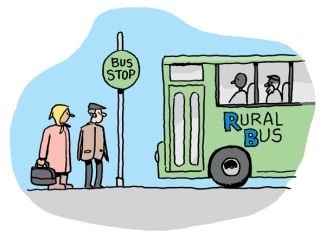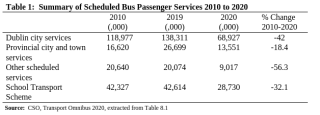Public transport must focus on rural areas and sustainability

According to the National Travel Survey 2019, 73.7 per cent of all journeys taken in 2019 were by private car (as driver or passenger), whereas public transport accounted for just 4.8 per cent of all journeys. [1] Those in densely populated areas were less likely to use a car than those in thinly populated areas, with private cars accounting for 61.7 per cent of all journeys in urbanised areas, compared to 83.8 per cent in thinly populated areas. Public transport was used over four times as much in densely populated areas than thinly populated areas reflecting the greater availability of public transport in more densely populated areas.
The Transport Omnibus 2020 [2] showed an overall increase in passengers on public transport between 2010 and 2019 but decreasing for 2020 due to travel restrictions (Table 1.) In addition to the 68.9 million bus passengers in Dublin city, over 19.2 million passengers used the two Luas lines in 2020, 12.8 million passengers used the Dublin suburban rail and DART services with decreasing numbers across all modes of transport due to travel restrictions imposed in March of 2020.

Bicycles
The bicycle sharing scheme in Dublin saw 1.78 million journeys undertaken in 2020, a decline from 3.8 million from 2019 and continuing the downward trend since 2016. When we compare data since 2015, the year in which all four bicycle schemes were operational, we see a decline in journey numbers even pre-Covid, year on year, since 2016 in Dublin, Cork and Limerick (Table 2). The bicycle sharing scheme is an excellent initiative and supports environmentally sustainable commuting in urban centres. However, without hard infrastructure for cycle lanes, our continued reliance on private cars for urban commutes makes city-cycling hazardous. Social Justice Ireland therefore calls on Government to expedite the introduction of hard infrastructure to support safe cycling in our cities.

Rural Transport
The lack of reliable public transport in rural areas means that rural households are more reliant on their car to access basic services and commute to and from work and school. This reliance is contributing to our carbon footprint, with transport being one of the three main contributing industries. Whilst transport emissions were reduced in 2020 by 15.7 per cent, passenger cars were responsible for 59 per cent of that. [3] Government expenditure on public transport as a percentage of total land transport expenditure has fluctuated since 2002, reaching a low of 30 per cent in 2006. The proportion of the spending allocation for public and sustainable transport in 2020 was 45 per cent. [4]

GIVING A VOICE TO THOSE
WHO DON’T HAVE A VOICE
When you support Social Justice Ireland, you are tackling the causes of problems.
Covid 19
Covid 19 created a shift in the use of public and private transport. For example, Dublin City Council implemented Covid Mobility measures, increasing cycle lanes and the width of pavements by decreasing access for private car use, many of which are still in place despite the lifting of travel restrictions. As of April 2022, bus and rail journeys across the country are still below pre Covid-19 levels with journeys for the week commencing 24th April at 77 per cent of journeys undertaken in March 2020. This is the highest level since March 2020. Rail travel (includes Intercity and DART services) in particular are still low, with journeys only reaching 63 per cent of pre Covid-19 levels. Luas journeys increased by 86 per cent between the beginning of January 2022 to the end of April but are still also below pre Covid-19 levels. Many may still be working from home meaning less commuters. [5]
Infrastructure must be in place to support thinly populated areas to grow and thrive, while those living in Dublin and surrounds, with access to an extensive public transport network, should be encouraged and incentivised to use it. We must look at measures implemented due to Covid-19, particularly in relation to walking tracks and cycling lanes, and work towards making these a more permanent transport feature.
[1] Central Statistics Office. (2020). National Travel Survey 2019. Dublin: Central Statistics Office.
[2] Central Statistics Office. (2021). Transport Omnibus 2020. Dublin: Central Statistics Office.
[4] Irish Government Economic and Evaluation Service. (2021). Transport Trends 2020. An Overview of Ireland’s Transport Sector. Dubin: IGEES.
[5] Central Statistics Office. (2022). Transport Bulletin May 2022. Central Statistics Office.
